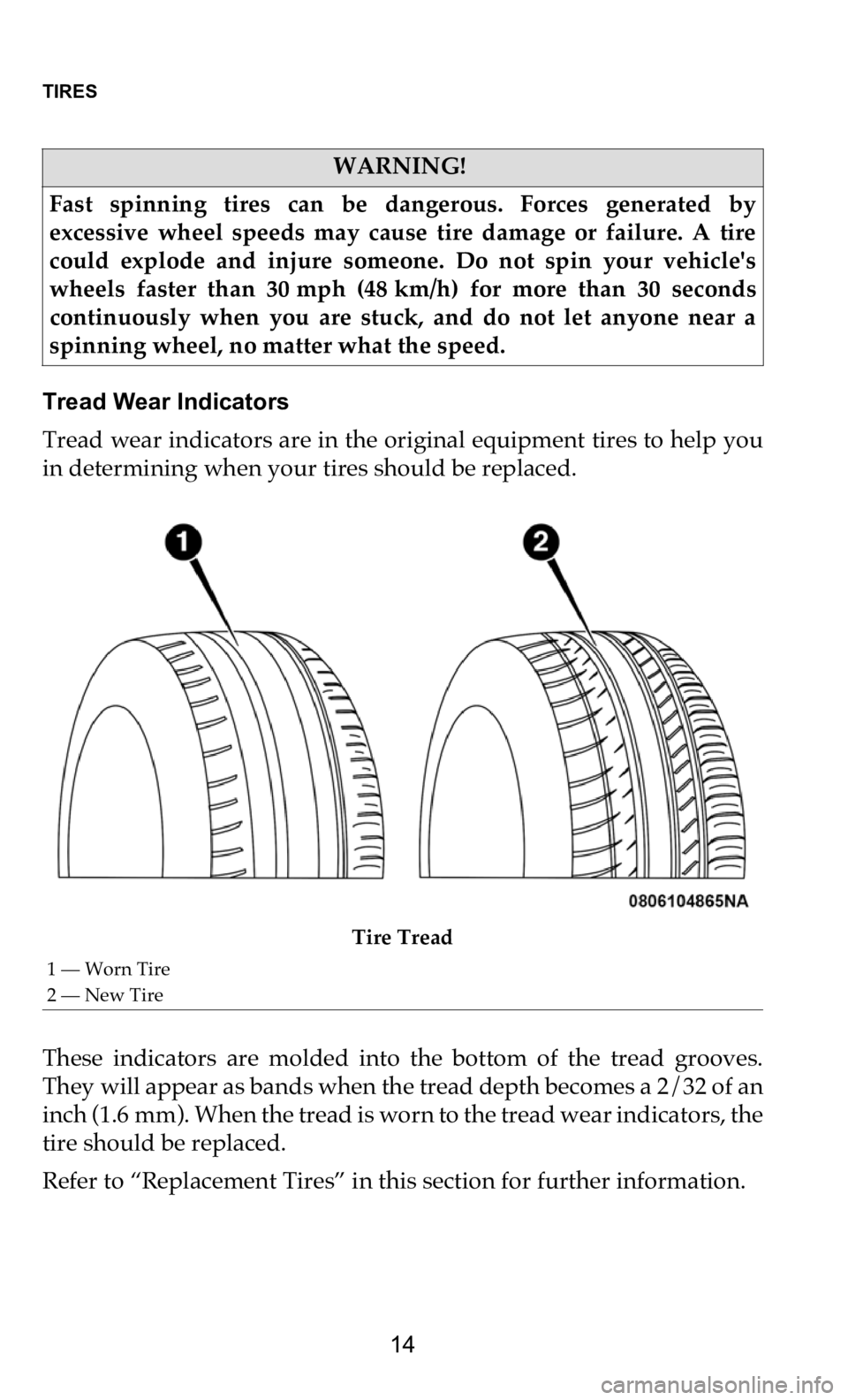DODGE CHARGER 2021 Vehicle Warranty
Manufacturer: DODGE, Model Year: 2021, Model line: CHARGER, Model: DODGE CHARGER 2021Pages: 262, PDF Size: 10.42 MB
Page 11 of 262

TIRES
10
Tires — General Information
Tire Pressure
Proper tire inflation pressure is essential to the safe and satisfactory
op
eration of your vehicle. Four primary areas are affected by
improper tire pressure:
• Safety and Vehicle Stability
•
Economy
•
Tread Wear
•
Ride Comfort
S
afety
Both underinflation and overinflation affect the stability of the vehicle
a n
d can produce a feeling of sluggish response or over responsiveness
in the steering.
NOTE:
• Unequal tire pressures from side to side may cause erratic and
unpredictable steering response.
• Unequal tire pressure from side to side may cause the vehicle to drift
l
eft or right.
WARNING!
• Improperly inflated tires are dangerous and can cause collisions.
•
Underinflation increases tire flexing and can result in over -
h
eating and tire failure.
• Overinflation reduces a tire's ability to cushion shock. Objects
o
n the road and chuckholes can cause damage that result in tire
failure.
• Overinflated or underinflated tires can affect vehicle handling
a
nd can fail suddenly, resulting in loss of vehicle control.
• Unequal tire pressures can cause steering problems. You could
l
ose control of your vehicle.
• Unequal tire pressures from one side of the vehicle to the other
c
an cause the vehicle to drift to the right or left.
• Always drive with each tire inflated to the recommended cold
t
ire inflation pressure.
Page 12 of 262

TIRES
11
Fuel Economy
Underinflated tires will increase tire rolling resistance resulting in
hi
gher fuel consumption.
Tread Wear
Improper cold tire inflation pressures can cause abnormal wear
pa
tterns and reduced tread life, resulting in the need for earlier tire
replacement.
Ride Comfort And Vehicle Stability
Proper tire inflation contributes to a comfortable ride. Overinflation
pr
oduces a jarring and uncomfortable ride.
Tire Inflation Pressures
The proper cold tire inflation pressure is listed on the driver side
B-
pillar or rear edge of the driver side door.
At least once a month:
• Check and adjust tire pressure with a good quality pocket-type
p
ressure gauge. Do not make a visual judgement when determining
proper inflation. Tires may look properly inflated even when they
are under-inflated.
• Inspect tires for signs of tire wear or visible damage.
I
nflation pressures specified on the placard are always “cold tire
in
flation pressure”. Cold tire inflation pressure is defined as the tire
pressure after the vehicle has not been driven for at least three hours,
or driven less than 1 mile (1.6 km) after sitting for a minimum of three
ho
urs. The cold tire inflation pressure must not exceed the maximum
inflation pressure molded into the tire sidewall.
Check tire pressures more often if subject to a wide range of outdoor
te
mperatures, as tire pressures vary with temperature changes.
Tire pressures change by approximately 1 psi (7 kPa) per 12°F (7°C) of
ai
r temperature change. Keep this in mind when checking tire
pressure inside a garage, especially in the Winter. CAUTION!
After inspecting or adjusting the tire pressure, always reinstall the
va
lve stem cap. This will prevent moisture and dirt from entering
the valve stem, which could damage the valve stem.
Page 13 of 262

TIRES
12
Example: If garage temperature = 68°F (20°C) and the outside
temperature = 32°F (0°C) then the cold tire inflation pressure should
be increased by 3 psi (21 kPa), which equals 1 psi (7 kPa) for every 12°F
(7°C) for this outside temperature condition.
Tire pressure may increase from 2 to 6 psi (13 to 40 kPa) during
op
eration. DO NOT reduce this normal pressure build up or your tire
pressure will be too low.
Tire Pressures For High Speed Operation
FCA US LLC advocates driving at safe speeds and within posted
sp
eed limits. Where speed limits or conditions are such that the
vehicle can be driven at high speeds, maintaining correct tire inflation
pressure is very important. Increased tire pressure and reduced
vehicle loading may be required for high-speed vehicle operation.
Refer to an authorized tire dealer or original equipment vehicle dealer
for recommended safe operating speeds, loading and cold tire
inflation pressures.
Radial Ply Tires
WARNING!
High speed driving with your vehicle under maximum load is
da
ngerous. The added strain on your tires could cause them to
fail. You could have a serious collision. Do not drive a vehicle
loaded to the maximum capacity at continuous speeds above
75 mph (120 km/h).
WARNING!
Combining radial ply tires with other types of tires on your
ve
hicle will cause your vehicle to handle poorly. The instability
could cause a collision. Always use radial ply tires in sets of four.
Never combine them with other types of tires.
Page 14 of 262

TIRES
13
Tire Repair
If your tire becomes damaged, it may be repaired if it meets the
fo
llowing criteria:
• The tire has not been driven on when flat.
•
The damage is only on the tread section of your tire (sidewall
d
amage is not repairable).
• The puncture is no greater than a ¼ of an inch (6
mm).
Consult an authorized tire dealer for tire repairs and additional
in
formation.
Damaged Run Flat tires, or Run Flat tires that have experienced a loss
of
pressure should be replaced immediately with another Run Flat tire
of identical size and service description (Load Index and Speed
Symbol).
Run Flat Tires — If Equipped
Run Flat tires allow you the capability to drive 50 miles (80 km) at
50
mph (80 km/h) after a rapid loss of inflation pressure. This rapid
lo
ss of inflation is referred to as the Run Flat mode. A Run Flat mode
occurs when the tire inflation pressure is of/or below 14 psi (96 kPa).
Once a Run Flat tire reaches the run flat mode it has limited driving
capabilities and needs to be replaced immediately. A Run Flat tire is
not repairable.
It is not recommended to drive a vehicle loaded at full capacity or to
to
w a trailer while a tire is in the Run Flat mode.
See the Tire Pressure Monitoring System section for more information.
Tire Spinning
When stuck in mud, sand, snow, or ice conditions, do not spin your
ve
hicle's wheels above 30 mph (48 km/h) or for longer than 30 seconds
co
ntinuously without stopping.
Refer to “Freeing A Stuck Vehicle” in “In Case Of Emergency” in your
Ow
ner’s Manual for further information.
Page 15 of 262

TIRES
14
Tread Wear Indicators
Tread wear indicators are in the original equipment tires to help you
in
determining when your tires should be replaced.
Tire Tread
These indicators are molded into the bottom of the tread grooves.
They will appear as bands when the tread depth becomes a 2/32 of an
inch (1.6 mm). When the tread is worn to the tread wear indicators, the
ti
re should be replaced.
Refer to “Replacement Tires” in this section for further information.
WARNING!
Fast spinning tires can be dangerous. Forces generated by
ex
cessive wheel speeds may cause tire damage or failure. A tire
could explode and injure someone. Do not spin your vehicle's
wheels faster than 30 mph (48 km/h) for more than 30 seconds
co
ntinuously when you are stuck, and do not let anyone near a
spinning wheel, no matter what the speed.
1 — Worn Tire
2 — New Tire
Page 16 of 262

TIRES
15
Life Of Tire
The service life of a tire is dependent upon varying factors including,
bu
t not limited to:
• Driving style.
•
Tire pressure - Improper cold tire inflation pressures can cause
u
neven wear patterns to develop across the tire tread. These
abnormal wear patterns will reduce tread life, resulting in the need
for earlier tire replacement.
• Distance driven.
•
Performance tires, tires with a speed rating of V or higher, and
S
ummer tires typically have a reduced tread life. Rotation of these
tires per the vehicle scheduled maintenance is highly recom -
mended.
Keep dismounted tires in a cool, dry place with as little exposure to
l i
ght as possible. Protect tires from contact with oil, grease, and
gasoline.
Replacement Tires
The tires on your new vehicle provide a balance of many
ch
aracteristics. They should be inspected regularly for wear and
correct cold tire inflation pressures. FCA US LLC strongly
recommends that you use tires equivalent to the originals in size,
quality and performance when replacement is needed. Refer to the
paragraph on “Tread Wear Indicators” in this section. Refer to the Tire
and Loading Information placard or the Vehicle Certification Label for
the size designation of your tire. The Load Index and Speed Symbol
for your tire will be found on the original equipment tire sidewall.
See the Tire Sizing Chart example found in the “Tire Safety
In
formation” section of this manual for more information relating to
the Load Index and Speed Symbol of a tire.
WARNING!
Tires and the spare tire should be replaced after six years,
re
gardless of the remaining tread. Failure to follow this warning
can result in sudden tire failure. You could lose control and have a
collision resulting in serious injury or death.
Page 17 of 262

TIRES
16
It is recommended to replace the two front tires or two rear tires as a
pair. Replacing just one tire can seriously affect your vehicle’s
handling. If you ever replace a wheel, make sure that the wheel’s
specifications match those of the original wheels.
It is recommended you contact an authorized tire dealer or original
eq
uipment dealer with any questions you may have on tire
specifications or capability. Failure to use equivalent replacement tires
may adversely affect the safety, handling, and ride of your vehicle.
WARNING!
• Do not use a tire, wheel size, load rating, or speed rating other
t
han that specified for your vehicle. Some combinations of unap -
proved tires and wheels may change suspension dimensions and
pe
rformance characteristics, resulting in changes to steering,
handling, and braking of your vehicle. This can cause unpredict -
able handling and stress to steering and suspension compo -
nents. You could lose control and have a collision resulting in
se
rious injury or death. Use only the tire and wheel sizes with
load ratings approved for your vehicle.
• Never use a tire with a smaller load index or capacity, other than
w
hat was originally equipped on your vehicle. Using a tire with
a smaller load index could result in tire overloading and failure.
You could lose control and have a collision.
• Failure to equip your vehicle with tires having adequate speed
c
apability can result in sudden tire failure and loss of vehicle
control.
CAUTION!
Replacing original tires with tires of a different size may result in
fa
lse speedometer and odometer readings.
Page 18 of 262

TIRES
17
Tire Types
All Season Tires — If Equipped
All season tires provide traction for all seasons (Spring, Summer,
Au
tumn, and Winter). Traction levels may vary between different all
season tires. All season tires can be identified by the M+S, M&S, M/S
or MS designation on the tire sidewall. Use all season tires only in sets
of four; failure to do so may adversely affect the safety and handling
of your vehicle.
Summer Or Three Season Tires — If Equipped
Summer tires provide traction in both wet and dry conditions, and are
no
t intended to be driven in snow or on ice. If your vehicle is equipped
with summer tires, be aware these tires are not designed for winter or
cold driving conditions. Install winter tires on your vehicle when
ambient temperatures are less than 40°F (5°C) or if roads are covered
with ice or snow. For more information, contact an authorized dealer.
Summer tires do not contain the all season designation or mountain/
sn
owflake symbol on the tire sidewall. Use summer tires only in sets
of four; failure to do so may adversely affect the safety and handling
of your vehicle.
Snow Tires
Some areas of the country require the use of snow tires during the
w i
nter. Snow tires can be identified by a “mountain/snowflake”
symbol on the tire sidewall.
If you need snow tires, select tires equivalent in size and
type to the original equipment tires. Use snow tires only
in
sets of four; failure to do so may adversely affect the
safety and handling of your vehicle.
Snow tires generally have lower speed ratings than
wh
at was originally equipped with your vehicle and
should not be operated at sustained speeds over 75 mph (120 km/h).
WARNING!
Do not use Summer tires in snow/ice conditions. You could lose
ve
hicle control, resulting in severe injury or death. Driving too
fast for conditions also creates the possibility of loss of vehicle
control.
Page 19 of 262

TIRES
18
For speeds above 75 mph (120 km/h) refer to original equipment or an
au
thorized tire dealer for recommended safe operating speeds,
loading and cold tire inflation pressures.
While studded tires improve performance on ice, skid and traction
ca
pability on wet or dry surfaces may be poorer than that of
non-studded tires. Some states prohibit studded tires; therefore, local
laws should be checked before using these tire types.
Spare Tires — If Equipped
S
pare Tire Matching Original Equipped Tire And Wheel — If
Eq
uipped
Your vehicle may be equipped with a spare tire and wheel equivalent
in
look and function to the original equipment tire and wheel found
on the front or rear axle of your vehicle. This spare tire may be used in
the tire rotation for your vehicle. If your vehicle has this option, refer
to an authorized tire dealer for the recommended tire rotation pattern.
Compact Spare Tire — If Equipped
The compact spare is for temporary emergency use only. You can
id
entify if your vehicle is equipped with a compact spare by looking
at the spare tire description on the Tire and Loading Information
Placard located on the driver side door opening or on the sidewall of
the tire. Compact spare tire descriptions begin with the letter “T” or
“S” preceding the size designation. Example: T145/80D18 103M.
T, S = Temporary Spare Tire
Since this tire has limited tread life, the original equipment tire should
be
repaired (or replaced) and reinstalled on your vehicle at the first
opportunity.
Do not install a wheel cover or attempt to mount a conventional tire
on
the compact spare wheel, since the wheel is designed specifically
for the compact spare tire. Do not install more than one compact spare
tire and wheel on the vehicle at any given time. CAUTION!
Because of the reduced ground clearance, do not take your vehicle
t h
rough an automatic car wash with a compact or limited use
temporary spare installed. Damage to the vehicle may result.
Page 20 of 262

TIRES
19
Collapsible Spare Tire — If Equipped
The collapsible spare is for temporary emergency use only. You can
id
entify if your vehicle is equipped with a collapsible spare by looking
at the spare tire description on the Tire and Loading Information
Placard located on the driver side door opening or on the sidewall of
the tire.
Collapsible spare tire description example: 165/80-17 101P.
Since this tire has limited tread life, the original equipment tire should
be
repaired (or replaced) and reinstalled on your vehicle at the first
opportunity.
Inflate collapsible tire only after the wheel is properly installed to the
ve
hicle. Inflate the collapsible tire using the electric air pump before
lowering the vehicle.
Do not install a wheel cover or attempt to mount a conventional tire
on
the collapsible spare wheel, since the wheel is designed specifically
for the collapsible spare tire.
WARNING!
Compact and collapsible spares are for temporary emergency use
on
ly. With these spares, do not drive more than 50 mph (80 km/h).
Te
mporary use spares have limited tread life. When the tread is
worn to the tread wear indicators, the temporary use spare tire
needs to be replaced. Be sure to follow the warnings, which apply
to your spare. Failure to do so could result in spare tire failure and
loss of vehicle control.
WARNING!
Compact and Collapsible spares are for temporary emergency use
on
ly. With these spares, do not drive more than 50 mph (80 km/h).
Te
mporary use spares have limited tread life. When the tread is
worn to the tread wear indicators, the temporary use spare tire
needs to be replaced. Be sure to follow the warnings, which apply
to your spare. Failure to do so could result in spare tire failure and
loss of vehicle control.